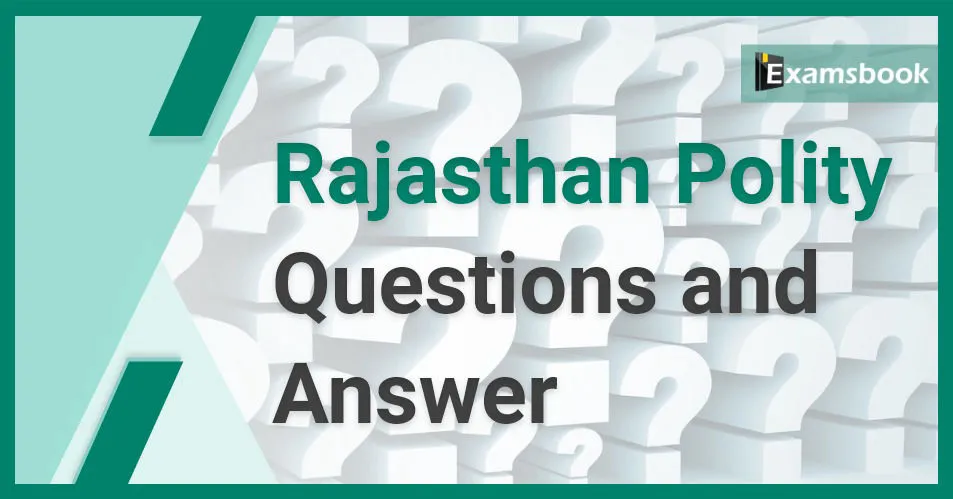


Who was the chairman of the committee which recommended democratic decentralization and Panchayati Raj?
(A) Balwant Rai Mehta
(B) Eka. H. Kanjur
(C) none of these
(D) M.M. Poonchi
1. The Ministry of Panchayati Raj is a branch of the Government of India that looks after the ongoing process of decentralization and local governance in the states.
2. The Panchayati Raj system is the system of local self-government in rural India. Just as self-governance of urban areas is carried out through municipalities and suburban municipalities, similarly self-governance of rural areas is carried out through Panchayati Raj institutions.
3. There are three levels of Panchayati Raj institutions.
(1) Village level: Gram Panchayat
(2) Block level: Panchayat Samiti
(3) District level: District Council
4. Balwant Rai Mehta recommended democratic decentralization in 1957.
In any of the following Constitution (Amendment) Acts, a provision has been made to make the same person the Governor of two or more states.
(A) in the Fourth Amendment
(B) in the Seventh Amendment
(C) in the Eleventh Amendment
(D) Twenty-fourth amendment
7th Constitutional Amendment Act of 1956 promoted the appointment of the same person as a governor for two or more states. It is related to the reorganisation of states. 7th Constitutional Amendment also provided for the appointment of additional and acting judges of the high court.
The election of Gram Panchayat is dependent on the?
(A) On the collector
(B) On the Election Commission
(C) On State Government
(D) On the divisional level
Gram Panchayat elections in India occur every five years. The village is divided into wards, and people in each ward vote for their representative. These elected members, along with the president (sarpanch) and vice president, form the Gram Panchayat.
Article 156 of the Constitution provides that the Governor shall hold office for a term of five years from the date on which he enters upon his office. Which of the following conclusions can be drawn from this.
(1) A Governor cannot be removed from office before the completion of his term.
(2) A Governor cannot continue in office after a period of five years.
Select the correct answer from the codes given below
(A) only 1
(B) 2 only
(C) 1 and 2 (both)
(D) not both
The governor holds for a term of 5 years from the date on which he joins his office, subject to the foregoing provision. A governor continues to hold his office until his successor joins the office, even after his expiration of his term. Therefore the correct answer is D.
Who appoints the Governor?
(A) President
(B) Prime Minister
(C) Chief Minister
(D) none of these
The Governor of a State is appointed by the President for a term of five years and holds office during his pleasure. Only Indian citizens above 35 years of age are eligible for appointment to this office. Executive power of the State is vested in Governor.
Consider the following statements regarding the Governor of Rajasthan :
(1) He is the Chancellor of the Central University of Rajasthan.
(2) He can hold any office of profit in the State.
(3) He is the President of the Indian Red Cross Society, Rajasthan State Branch.
(4) They do not have any self-discretionary power under the Constitution.
Which of the above statement(s) is/are correct?
(A) both 2 and 3
(B) 3 only
(C) 2 , 3 and 4
(D) 1, 2, 3 and 4
1. The Governor is the ex-officio Chancellor of the State Universities.
2. The Governor appoints the Vice-Chancellor on the advice/consultation with the State Government.
3. The Chancellor also presides over the convocation of state universities.
4. The Chancellor appoints his nominees to various bodies such as the Senate, Syndicate, Board of Management, Selection Committee and Academic Council of State Universities.
5. He is the President of the Indian Red Cross Society, Rajasthan State Branch.
Which of the following powers is not vested in the Governor of Rajasthan?
(A) adjournment of the assembly
(B) prorogation of the Legislative Assembly
(C) to summon the assembly
(D) dissolution of the assembly
The correct answer is To adjourn the Legislative Assembly. Article 174, a governor shall summon the House at a time and place, as she or he thinks fit.
According to Article 213 of the Constitution, the Governor has the power to issue ordinances.
(A) discretionary
(B) Executive
(C) This power is exercised in consultation with the cabinet
(D) in consultation with the Central Government
The Governor of a state can also issue ordinances under Article 213 of the Constitution of India, when the state legislative assembly is not in session. If the two Houses start their sessions on different dates, the later date is considered (Articles 123 and 213).
In the President's rule, who is the main governing director of the state?
(A) Governor
(B) Prime Minister
(C) Chief Minister
(D) Parliament
The dismissal of a state government and imposing direct authority of the Centre is known as President's Rule. The territory in dispute is taken over by the central government, and the Governor assumes the region's constitutional leadership.
Who was the Governor of Rajasthan at the time of proclamation under Article 356 in Rajasthan in 1992?
(A) Raghukul Tilak
(B) Darbar Singh
(C) M.Chennareddy
(D) Anshuman Singh
Marri Chenna Reddy is the governor of Rajasthan at the time of imposing the fourth President's rule in Rajasthan.
Get the Examsbook Prep App Today